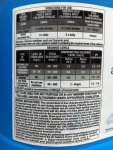Question about Chlorine levels based on CYA and "Recommended 4ppm guidelines"
Hi everyone. I've been following the advice here and doing my daily testing. I've passed the OCLT, but im waiting for a small leak to be repaired and as such, losing a little water everyday and having to kick up my FC about 2-3ppm every 1-2 days.
As such, I've been adding anywhere from 30-98 oz of liquid chlorine a day to keep levels at about 7-8ppm with a CYA of around 60 and CC 0-0.5.
My question is about the warnings that appear on bottles of liquid chlorine. The warnings state that you shouldn't enter the water unless the chlorine level is below 4ppm. Now, I know we adjust our levels based on the CYA in the pool, but my question is - why don't the chlorine manufacturers, who have nothing but incentive (more chlorine usage = more money) to do so, state higher PPM if CYA is accounted for?
I really am fearful that the 7-8ppm FC level I am keeping is "too high" and that it becomes more dangerous to swimmers at the level. This is purely a fear based on the fact that all labels regarding chlorine indicate 4ppm as a max before swimmers can enter. Why wouldn't the chlorine manufacturer say "you can go in at higher levels if CYA is higher?"
Also, I get that we adjust Chlorine levels for CYA because the CYA makes it less efficient - but does that mean it has a reduced impact on swimmers too? I mean it's still in the water, still going against your skin and eyes. Does the CYA make it sting less against your eyes or does it simply make it less effective for killing bacteria?
I am just a worry-wart and need some science to backup keeping my chlorine levels where they are. I get the science behind the CYA association, but still fear how that impacts humans in the water.
Help put me at ease with some science!
Hi everyone. I've been following the advice here and doing my daily testing. I've passed the OCLT, but im waiting for a small leak to be repaired and as such, losing a little water everyday and having to kick up my FC about 2-3ppm every 1-2 days.
As such, I've been adding anywhere from 30-98 oz of liquid chlorine a day to keep levels at about 7-8ppm with a CYA of around 60 and CC 0-0.5.
My question is about the warnings that appear on bottles of liquid chlorine. The warnings state that you shouldn't enter the water unless the chlorine level is below 4ppm. Now, I know we adjust our levels based on the CYA in the pool, but my question is - why don't the chlorine manufacturers, who have nothing but incentive (more chlorine usage = more money) to do so, state higher PPM if CYA is accounted for?
I really am fearful that the 7-8ppm FC level I am keeping is "too high" and that it becomes more dangerous to swimmers at the level. This is purely a fear based on the fact that all labels regarding chlorine indicate 4ppm as a max before swimmers can enter. Why wouldn't the chlorine manufacturer say "you can go in at higher levels if CYA is higher?"
Also, I get that we adjust Chlorine levels for CYA because the CYA makes it less efficient - but does that mean it has a reduced impact on swimmers too? I mean it's still in the water, still going against your skin and eyes. Does the CYA make it sting less against your eyes or does it simply make it less effective for killing bacteria?
I am just a worry-wart and need some science to backup keeping my chlorine levels where they are. I get the science behind the CYA association, but still fear how that impacts humans in the water.
Help put me at ease with some science!


